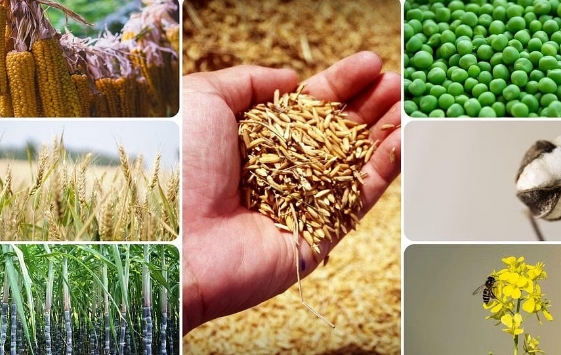

CBSE Class 8 Geography Notes Chapter 4: Chapter 4 of CBSE Class 8 Geography, "Agriculture," delves into the fundamental role of agriculture in human society, emphasizing its significance as a primary occupation, especially in rural areas. The chapter explores various types of farming, including subsistence, commercial, and plantation agriculture. It discusses factors influencing agricultural practices, such as climate, soil, and topography, and introduces key crops like rice, wheat, and cotton.
The chapter also covers the Green Revolution's impact, highlighting advancements in agricultural technology and productivity, and addresses the challenges faced by farmers in sustaining agricultural practices amid changing environmental and economic conditions.CBSE Class 8 Geography Notes Chapter 4 Overview
Chapter 4 of CBSE Class 8 Geography, titled "Agriculture," provides an overview of the different types of agriculture practiced globally and in India. It highlights the importance of agriculture as the primary occupation in rural areas, providing food and raw materials.The chapter covers various farming types, such as subsistence, commercial, and plantation farming. It explains the factors affecting agriculture, including climate, soil, and topography. The chapter also discusses the major crops grown in different regions, such as rice, wheat, and cotton, and the impact of modern farming techniques and Green Revolution on agricultural productivity.
CBSE Class 8 Geography Notes Chapter 4 PDF Download
Here we have provided CBSE Class 8 Geography Notes Chapter 4 Agriculture pdf for the ease of students so that they can download it and access it offline.CBSE Class 8 Geography Notes Chapter 4 PDF
CBSE Class 8 Geography Notes Chapter 4 Agriculture Quick Revision Notes
Here we have provided CBSE Class 8 Geography Notes Chapter 4 Agriculture - Primary, secondary, and tertiary economic activities are all involved in the process of turning a plant into a finished good. The production and extraction of natural resources are primary activities. Examples include fishing, hunting, and agriculture. The processing of these resources is considered a secondary activity. Examples include the production of steel, bread, and textiles. Tertiary activities: offer services to support the elementary and secondary sectors. Transport, trade, finance, insurance, and advertising are a few examples. Agriculture is a primary activity. Favourable topography of soil and climate is vital for agricultural activity.Farm System
One way to think of farming or agriculture is as a system. Important inputs include labour, machinery, fertilisers, and seeds. Ploughing, planting, watering, weeding, and harvesting were among the operations. The system's outputs include dairy, poultry, wool, and crops.Types of Farming
Both commercial and subsistence farming are viable farming practices, depending on labour availability, crop demand, geographic conditions, and technological advancements. There are two types of subsistence farming: primitive and intense subsistence farming.| Subsistence farming | Intensive subsistence agriculture | Primitive subsistence agriculture |
| The type of farming is practised to meet the needs of the farmer’s family. | The farmer cultivates a small plot of land using simple tools and more labour. Climate with a large number of days with sunshine and fertile soils permit the growing of more than one crop annually on the same plot. | Includes shifting cultivation and nomadic herding. Shifting Cultivation – a plot of land is cleared by felling the trees and burning them. The ashes are then mixed with the soil and crops are grown. After the soil loses its fertility, the land is abandoned, and the cultivator moves to a new plot. Shifting cultivation is also known as ‘slash and burn’ agriculture.
Nomadic Herding -herdsmen move from place to place with their animals for fodder and water along defined routes. This type of movement arises in response to climatic constraints and terrain. |
| Main Crop Other Crops | RiceWheat, maize, pulses and oilseeds | Shifting Cultivation – maize, yam, potatoes and cassava Nomadic Herding -Sheep, camel, yak and goats are most commonly reared. They provide milk, meat, wool, hides and other products to the herders and their families. |
| Areas | Prevalent in the thickly populated areas of the monsoon regions of South, South-East and East Asia. | Shifting Cultivation -practised in the thickly forested areas of the Amazon basin, tropical Africa, parts of Southeast Asia and Northeast India. Nomadic Herding – practised in the semi-arid and arid regions of Sahara, Central Asia and some parts of India, like Rajasthan and Jammu and Kashmir. |
Commercial Farming – Commercial grain farming, mixed farming and plantation agriculture
| Commercial Farming | Commercial grain farming | Mixed Farming | Plantation Agriculture |
| Crops are grown, and animals reared-sale in the market. The large area is cultivated, and a large amount of capital is used. Work done by machines. | Crops are grown for commercial purposes.These areas are sparsely populated, with large farms spreading over hundreds of hectares. Severe winters restrict the growing season, and only a single crop can be grown. | The land is used for growing food and fodder crops and rearing livestock | A type of commercial farming where a single crop is grown. A large amount of labour and capital are required. The produce may be processed on the farm itself or in nearby factories. The development of a transport network is thus essential for such farming. |
| Crops | Wheat and maize | Tea, coffee, sugarcane, cashew, rubber, banana or cotton | |
| Areas | Temperate grasslands of North America, Europe and Asia | Practised in Europe, eastern USA, Argentina, southeast Australia, New Zealand and South Africa | Major plantations are found in the tropical regions of the world. Rubber in Malaysia, coffee in Brazil, tea in India and Sri Lanka |
Major Crops
- Major food crops – wheat, rice, maize and millet.
- Fibre crops -jute and cotton
- Important beverage crops -tea and coffee

Rice
The primary food source for people living in tropical and subtropical countries is rice, which grows best on alluvial clayey soil that can hold onto water. China is the world's top producer of rice, followed by India, Japan, Sri Lanka, and Egypt.-In regions with good climates, like as West Bengal and Bangladesh, two to three crops are grown year.Wheat
Wheat is grown extensively in the USA, Canada, Argentina, Russia, Ukraine, Australia, and India. It grows best in well-drained loamy soil and needs moderate temperatures and rainfall during the growth season. In India, it is grown in the winter.Millets
Coarse grains, or millets, are a resilient crop that require low rainfall, high to moderate temperatures, and sufficient rainfall. While they are planted in India, they are also grown in Nigeria, China, and Niger. Jowar, bajra, and ragi are examples of millets.Maize
Grown across North America, Brazil, China, Russia, Canada, India, and Mexico, maize needs well-drained, productive soils with enough of sunshine and moderate temperatures and rainfall.Cotton
Cotton grows best on dark and alluvial soils and needs high temperatures, little precipitation, 210 days without frost, and bright sunshine to flourish.China, the United States, India, Pakistan, Brazil, and Egypt are the top producers of cotton, which is a key raw material for the cotton textile sector.Jute
Jute, sometimes referred to as the "Golden Fibre," thrives in alluvial soil and is grown in tropical regions where it needs high temperatures, a lot of rain, and humidity.Bangladesh and India are the world's two biggest jute producers.Coffee
Coffee grows best on hill slopes with well-drained loamy soil and a warm, humid climate. Brazil is the world's top producer, followed by Columbia and India.Tea
The best tea in the world is produced in Kenya, India, China, and Sri Lanka. Tea is a beverage crop grown on plantations that needs a cool temperature with evenly spaced high rainfall throughout the year for the growth of its fragile leaves. It also needs well-drained loamy soils and moderate slopes.Agricultural Development
In order to meet the growing demand of the growing population, efforts were made to increase farm productivity. This was accomplished in a number of ways, including by increasing the cropped area, the number of crops grown, improving irrigation systems, using fertilisers, and growing high-yielding varieties of seeds. The ultimate goal of agricultural development is to increase food security. Large population developing nations engage in intensive agriculture, with larger holdings being preferred for commercial agriculture. Crops are farmed on small holdings primarily for subsistence.Benefits of CBSE Class 8 Geography Notes Chapter 4
The benefits of studying CBSE Class 8 Geography Notes for Chapter 4 "Agriculture" include:Foundational Knowledge : Provides a solid understanding of different types of agriculture and their significance, helping students grasp the basics of farming practices.
Exam Preparation : Summarized notes aid in efficient revision, making it easier for students to prepare for exams with a clear understanding of key concepts.
Real-World Relevance : Helps students relate classroom knowledge to real-world agricultural practices, making learning more practical and meaningful.
Improved Understanding : Simplifies complex topics like the Green Revolution, modern farming techniques, and the impact of climate on agriculture.
Critical Thinking : Encourages students to think about the challenges faced in agriculture and the importance of sustainable farming practices in today's world.
CBSE Class 8 Geography Notes Chapter 4 FAQs
What is Chapter 4 of geography Class 8 about?
What is a short note on farm system Class 8?
What is a short note on agricultural development class 8?
What is subsistence farming Class 8 notes?
Who is the father of geography class 8?











